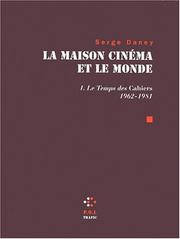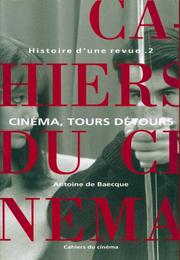| Listing 1 - 10 of 11 | << page >> |
Sort by
|
Book
ISBN: 8831747312 Year: 1984 Publisher: Venezia Marsilio
Abstract | Keywords | Export | Availability | Bookmark
 Loading...
Loading...Choose an application
- Reference Manager
- EndNote
- RefWorks (Direct export to RefWorks)
Book
ISBN: 9781844677603 1844677605 Year: 2011 Publisher: London Verso
Abstract | Keywords | Export | Availability | Bookmark
 Loading...
Loading...Choose an application
- Reference Manager
- EndNote
- RefWorks (Direct export to RefWorks)
The crucible -- The yellow years -- Marble to modern chemistry -- Politicization -- Red notebooks -- The Daney years -- The mainstream -- After Cahiers -- Afterword -- Index of names and films cited.
Motion pictures --- Periodicals --- History. --- Cahiers du cinéma --- film --- 791.43 --- Frankrijk --- nouvelle vague --- filmtheorie --- filmgeschiedenis --- filmtijdschriften --- twintigste eeuw --- Cahiers du Cinéma --- History --- Cahiers du cinéma
Book
ISBN: 9048519454 9089645543 Year: 2015 Publisher: Amsterdam University Press
Abstract | Keywords | Export | Availability | Bookmark
 Loading...
Loading...Choose an application
- Reference Manager
- EndNote
- RefWorks (Direct export to RefWorks)
Jean-Louis Comolli’s six-part essay Technique and Ideology had a revolutionary effect on film theory and history when it first appeared in Cahiers du Cinéma in 1971. In 2009, Comolli revisited his earlier text, arguing that the present age, marked by the total dominance of media-filtered spectacle over image production, makes the need for an 'emancipated, critical spectator' more pressing than ever. In this volume, Daniel Fairfax presents annotated translations of these two texts to provide an overview of Comolli’s activity as both a theorist and a filmmaker.
Book
ISBN: 9048543908 9463721010 9789463728508 9463728503 9789048543908 9789463721011 9463728600 9789463728607 9463728600 9789463728607 Year: 2021 Publisher: Amsterdam : Amsterdam University Press,
Abstract | Keywords | Export | Availability | Bookmark
 Loading...
Loading...Choose an application
- Reference Manager
- EndNote
- RefWorks (Direct export to RefWorks)
The uprising which shook France in May 1968 also had a revolutionary effect on the country's most prominent film journal. Under editors Jean-Louis Comolli and Jean Narboni, Cahiers du cinéma embarked on a militant turn that would govern the journal's work over the next five years. With a Marxist orientation inspired by the thinking of Louis Althusser, Jacques Lacan and Roland Barthes, the "red years" of Cahiers du cinéma produced a theoretical outpouring that was formative for the establishment of film studies as an academic discipline in the 1970s, and is still of vital relevance for the contemporary audiovisual landscape. It was also the seminal experience for a generation of critics who have dedicated the following half-century to the task of critically responding to the cinema. The Red Years of Cahiers du Cinéma (1968-1973) gives a historical overview of this period in the journal's history, combining biographical accounts of the critics who were involved with Cahiers in the post-1968 and theoretical explorations of the text they wrote. Volume II centers on questions of aesthetics and the cinema's ontological relationship with the real.
cinema --- film --- filmkritiek --- Frankrijk --- filmgeschiedenis --- filmtheorie --- marxisme --- mei '68 --- 20e eeuw (twintigste eeuw) --- E-books --- Motion pictures --- HISTORY / Social History. --- Periodicals. --- Cahiers du cinéma, film theory, apparatus theory, political modernism, French cinema. --- Cinema --- Feature films --- Films --- Movies --- Moving-pictures --- Audio-visual materials --- Mass media --- Performing arts --- History and criticism --- Cahiers du cinema. --- Cahiers du cinéma --- France
Book
ISBN: 9789490334017 Year: 2011 Publisher: Amsterdam Octavo
Abstract | Keywords | Export | Availability | Bookmark
 Loading...
Loading...Choose an application
- Reference Manager
- EndNote
- RefWorks (Direct export to RefWorks)
"Volharden is de 'autobiografie' van de bekende Franse filmcriticus Serge Daney. De tekst is gebaseerd op gesprekken met Serge Toubiana, die vlak voor Daneys voortijdige dood in 1992 werden afgerond. Daney begon in 1964 voor de Cahiers du cinéma over film te schrijven en richtte vanaf de jaren tachtig zijn aandacht tevens op televisie, reclame en nieuwe media. Volharden is een diepgaande analyse van Daneys engagement met de cinema, maar hij liet voor het eerst ook zijn persoonlijke levensverhaal doorklinken in het theoretische discours en gaf het daarmee zijn werkelijke draagwijdte. Het resultaat is een cinebiografie."--
Daney, Serge --- film --- filmtheorie --- filmkritiek --- Frankrijk --- Cahiers du Cinéma --- twintigste eeuw --- Daney Serge --- 791.41 --- 798.3 --- biografieën --- film, esthetiek en kritiek
Book
ISBN: 9789490334048 Year: 2011 Publisher: Amsterdam : Octavo,
Abstract | Keywords | Export | Availability | Bookmark
 Loading...
Loading...Choose an application
- Reference Manager
- EndNote
- RefWorks (Direct export to RefWorks)
Flaptekst: 'Daney vertegenwoordigt voor mij het einde van de kritiek zoals ik die begrijp, en die ik laat beginnen bij Diderot, van D naar D, van Diderot naar Daney', stelde Jean-Luc Godard in een gesprek met Youssef Ishaghpour (Trafic, nr. 29). In 1964 schreef Serge Daney voor de Cahiers du cinéma zijn eerste artikel over film en vanaf de jaren tachtig richtte hij zich tevens op televisie, reclame en nieuwe media. Zijn teksten hebben grote invloed gehad op een hele generatie filmmakers, critici en filosofen, en vormen nog steeds een bron van inspiratie. Ze hebben nauwelijks aan betekenis ingeboet als het gaat om de lessen van een rijke cinefiele cultuur voor de hedendaagse beeldcultuur. Het beeld als verzet tegen de eindeloze informatiestroom, als ruimte voor verbeelding, als ruimte voor reflectie: een ruimte om in te bewegen.
Film --- Daney, Serge --- film --- filmtheorie --- filmkritiek --- media --- nieuwe media --- televisie --- twintigste eeuw --- Daney Serge --- 791.41 --- 798.3 --- Frankrijk --- Cahiers du Cinéma --- film, esthetiek en kritiek
Book
ISBN: 2866420187 9782866420185 Year: 1984 Publisher: Paris: Ed. de l'Etoile,
Abstract | Keywords | Export | Availability | Bookmark
 Loading...
Loading...Choose an application
- Reference Manager
- EndNote
- RefWorks (Direct export to RefWorks)
film --- filmtheorie --- Cahiers du Cinéma --- auteurtheorie --- Nouvelle Vague --- Bazin André --- Bitsch Charles --- filmkritiek --- Becker Jacques --- Chabrol Claude --- Domarchi Jean --- Delahaye Michel --- Doniol-Valcroze Jacques --- Douchet Jean --- Godard Jean-Luc --- Hoveyda Fereydoun --- Rivette Jacques --- Rohmer Eric --- Truffaut François --- Antonioni Michelangelo --- Bunuel Luis --- Bresson Robert --- Hawks Howard --- Hitchcock Alfred --- Lang Fritz --- Renoir jean --- Rossellini Roberto --- Welles Orson --- Dreyer Carl Theodor --- 791.471

ISBN: 9782818016343 9782867448126 9782867449079 9782818018552 2867448123 2867449073 2818016347 2818018552 Year: 2001 Publisher: Paris: POL,
Abstract | Keywords | Export | Availability | Bookmark
 Loading...
Loading...Choose an application
- Reference Manager
- EndNote
- RefWorks (Direct export to RefWorks)
Le premier volume est consacré essentiellement au temps des "Cahiers du cinéma", de 1962 à 1981; il raconte les années d'apprentissage de Serge Daney, sa découverte conjointe du cinéma et du monde, son engagement résolument politique, en rassemblant enfin la plupart de ses articles, souvent rares et inaccessibles, parfois inédits. Avec le deuxième volume s'amorce la publication des années Libé de Serge Daney. Nommé en 1981 responsable du Service cinéma, il quitte la rédaction en chef des "Cahiers" afin de se consacrer totalement à l'écriture au quotidien. Le troisième volume poursuit la publication des textes de Serge Daney non recueillis de son vivant, signés de son seul nom et parus, pour l'essentiel, dans le journal Libération. II continue d'écrire sur les films qui sortent en salles chaque semaine mais revisite aussi ceux, plus classiques, qu'il passe au crible de la télévision dans sa chronique des "Fantômes du permanent". Il s'engage plus encore dans le décryptage de l'information, de la publicité et des médias. Cet ouvrage regroupe les publications de S. Daney dans les Cahiers du Cinéma de 1981 à 1985. Le journaliste s'y laisse découvrir à travers ses réflexions, sa découverte du cinéma, et son engagement politique.
Films --- Télévision --- Comptes rendus --- Émissions --- Libération (périodique France 1973-....) --- Les cahiers du cinéma --- Libération --- Daney, Serge --- Les cahiers du cinéma --- Série Libération. --- Daney, Serge, --- Trafic (périodique ; France ; 1991-....) --- Libération (périodique ; France ; 1973-....) --- Motion pictures --- Cinéma --- Média --- Politique --- Presse --- Motion pictures. --- Film criticism --- Cinéma --- Critique cinématographique --- Reviews --- Trafic --- Comptes rendus. --- Motion pictures - Reviews
Book
ISBN: 9048543916 9789463728607 9463728600 9789048543915 Year: 2021 Publisher: Amsterdam : Amsterdam University Press,
Abstract | Keywords | Export | Availability | Bookmark
 Loading...
Loading...Choose an application
- Reference Manager
- EndNote
- RefWorks (Direct export to RefWorks)
The uprising which shook France in May 1968 also had a revolutionary effect on the country's most prominent film journal. Under editors Jean-Louis Comolli and Jean Narboni, Cahiers du cinéma embarked on a militant turn that would govern the journal's work over the next five years. With a Marxist orientation inspired by the thinking of Louis Althusser, Jacques Lacan and Roland Barthes, the "red years" of Cahiers du cinéma produced a theoretical outpouring that was formative for the establishment of film studies as an academic discipline in the 1970s, and is still of vital relevance for the contemporary audiovisual landscape. It was also the seminal experience for a generation of critics who have dedicated the following half-century to the task of critically responding to the cinema. The Red Years of Cahiers du Cinéma (1968-1973) gives a historical overview of this period in the journal's history, combining biographical accounts of the critics who were involved with Cahiers in the post-1968 and theoretical explorations of the text they wrote. Volume II centers on questions of aesthetics and the cinema's ontological relationship with the real.
film --- cinema --- filmkritiek --- Frankrijk --- filmgeschiedenis --- filmtheorie --- marxisme --- mei '68 --- 20e eeuw (twintigste eeuw) --- E-books --- Motion pictures --- HISTORY / Social History. --- Periodicals. --- Cahiers du cinéma, film theory, apparatus theory, political modernism, French cinema. --- Cinema --- Feature films --- Films --- Movies --- Moving-pictures --- Audio-visual materials --- Mass media --- Performing arts --- History and criticism

ISBN: 286642106X 2866421078 2866421094 2866421108 9782866421090 9782866421069 9782866421113 9782866421076 2866421116 9782866421106 Year: 2001 Publisher: Paris: Cahiers du cinéma,
Abstract | Keywords | Export | Availability | Bookmark
 Loading...
Loading...Choose an application
- Reference Manager
- EndNote
- RefWorks (Direct export to RefWorks)
Film --- Journalism --- anno 1950-1959 --- France --- Motion pictures --- Cinéma --- Periodicals --- History --- Périodiques --- Histoire --- Cahiers du cinéma --- #SBIB:309H522 --- Audiovisuele communicatie: kritiek --- Antoine de Baecque --- film --- filmtijdschriften --- filmgeschiedenis --- Frankrijk --- tijdschriften --- Bazin André --- Hitchcock Alfred --- Doniol-Valcroze Jacques --- Truffaut François --- nouvelle vague --- filmtheorie --- auteurtheorie --- film en politiek --- Hollywood --- Verenigde Staten --- Ray Nicholas --- Huston John --- Chabrol Claude --- Hawks Howard --- Lang Fritz --- Godard Jean-Luc --- Rohmer Eric --- Domarchi Jean --- Kast Pierre --- Renoir Jean --- Rivette Jacques --- Martin André --- Hoveyda Fereydoun --- 791.43 --- anno 1970-1979 --- anno 1960-1969 --- Cinéma --- Périodiques --- Cahiers du cinéma --- twintigste eeuw --- CDL --- Critique cinématographique. --- Motion pictures - Periodicals - History
| Listing 1 - 10 of 11 | << page >> |
Sort by
|

 Search
Search Feedback
Feedback About UniCat
About UniCat  Help
Help News
News